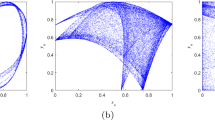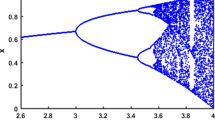Abstract
Some image encryption algorithms are difficult to resist the chosen-plaintext attack against special images, in order to solve this problem and improve the security of the algorithm, this paper proposes a novel image encryption scheme based on the chaotic system, random number embedding and DNA-level self-adaptive permutation and diffusion. The architecture of preprocessing, permutation and diffusion is adopted. Firstly, an image preprocessing based on random number embedding (IPRNE) is presented, specifically, embed random numbers into the plain image, and then perform partition XOR operation on random numbers and their surrounding pixels to preprocess plain image. The random numbers are generated by a 4D memristive hyperchaotic system, and their embedding positions are controlled by the pixel sums of plain images. Secondly, the obtained image is encoded into a DNA matrix by use of a DNA encoding rule, and then a DNA-level self-adaptive permutation and diffusion processes are successively performed on it. Further, after decoding the diffused matrix, the cipher image is obtained. Besides, the feature information of DNA sequences of plain image is applied for disturbing the permutation and diffusion phases, which may be extracted automatically in the decryption process, and thus additional transmission and storage are avoided. Moreover, the plain image information and hyperchaotic system are integrated to design the DNA encoding /decoding rule for the plain image and mask matrix, and this can enhance the ability of the algorithm to resist chosen-plaintext attack. Experimental results and security analyses demonstrate that the proposed encryption is secure and effective, and it can be applied for image secure communication.
















Similar content being viewed by others
References
Abu Dalhoum AL, Mahafzah BA, Awwad AA, Aldamari I, Ortega A, Alfonseca M (2012) Digital image scrambling using 2D cellular automata. IEEE Multimedia 19(4):28–36
Adleman LM (1994) Molecular computation of solutions of combinatorial problems. Science 266:1021–1024
Alvarez G, Li SJ (2006) Some basic cryptographic requirements for chaos-based cryptosystem. Int J Bifurcat Chaos 16:2129–2151
Belazi A, El-Latif AAA, Belghith S (2016) A novel image encryption scheme based on substitution-permutation network and chaos. Signal Process 128:155–170
Belazi A, El-Latif AAA, Diaconu AV (2017) Chaos-based partial image encryption scheme based on linear fractional and lifting wavelet transforms. Opt Lasers Eng 88:37–50
Chai XL, Gan ZH, Yuan K, Chen YR, Liu XX (2019) A novel image encryption scheme based on DNA sequence operations and chaotic systems. Neural Comput & Applic 31:219–237
Chai XL, Zhang JT, Gan ZH, Zhang YS (2019) Medical image encryption algorithm based on Latin square and memristive chaotic system. Multimed Tools Appl 78:35419–35453
Chai XL, Wu HY, Gan ZH, Zhang YS, Chen YR (2020) Hiding cipher-images generated by 2-D compressive sensing with a multi-embedding strategy. Signal Process 171:107525
Chai X L, Wu H Y, Gan Z H, Zhang Y S, Chen Y R, Kent W. Nixon (2020) An efficient visually meaningful image compression and encryption scheme based on compressive sensing and dynamic LSB embedding. Opt Lasers Eng 124: 105837
Chen JX, Zhu ZL, Zhang LB, Zhang YS, Yang BQ (2018) Exploiting self-adaptive permutation–diffusion and DNA random encoding for secure and efficient image encryption. Signal Process 142:340–353
Chen JX, Chen L, Zhou YC (2020) Cryptanalysis of a DNA-based image encryption scheme. Inf Sci 520:130–141
Eslami Z, Bakhshandeh A (2013) An improvement over an image encryption method based on total shuffling. Opt Commun 286(1):51–55
Fridrich J (1997) Image encryption based on chaotic maps. IEEE Int Conf Syst 2:1105–1110
Fridrich J (1998) Symmetric ciphers based on two-dimensional chaotic maps. Int J Bifurcat Chaos 8:1259–1284
Gan ZH, Chai XL, Yuan K, Lu Y (2018) A novel image encryption algorithm based on LFT based S-boxes and chaos. Multimed Tools Appl 77:8759–8783
Gan ZH, Chai XL, Han DJ, Chen YR (2019) A chaotic image encryption algorithm based on 3-D bit-plane permutation. Neural Comput & Applic 31:7111–7130
Gong LH, Qiu KD, Deng CZ, Zhou NR (2019) An optical image compression and encryption scheme based on compressive sensing and RSA algorithm. Opt Lasers Eng 121:169–180
Farah M. A. B, Guesmi R, Kachouri A, Samet M (2020) A novel chaos based optical image encryption using fractional Fourier transform and DNA sequence operation. Opt Laser Technol 121: 105777
Hermassi H, Belazi A, Rhouma R, Belghith SM (2014) Security analysis of an image encryption algorithm based on a DNA addition combining with chaotic maps. Multimed Tools Appl 72(3):2211–2224
Hua ZY, Zhou YC (2016) Image encryption using 2D Logistic-adjusted-Sine map. Inf Sci 339:237–253
Hua ZY, Zhou YC, Huang HJ (2019) Cosine-transform-based chaotic system for image encryption. Inf Sci 480:403–419
Huang XL, Ye GD (2014) An image encryption algorithm based on hyper-chaos and DNA sequence. Multimed Tools Appl 72:57–70
Jain A, Rajpal N (2016) A robust image encryption algorithm resistant to attacks using DNA and chaotic logistic maps. Multimed Tools Appl 75:5455–5472
Khan S, Han LS, Lu HW, Butt KK, Bachira G, Khan NU (2019) A new hybrid image encryption algorithm based on 2D-CA, FSM-DNA rule generator, and FSBI. IEEE Access 7:81333–81349
Kohli R, Kumar M (2013) FPGA implementation of cryptographic algorithms using multi-encryption technique. Int J Adv Res Comput Sci Softw Eng 3(5)
Li C, Feng B, Li S, Kurths J, Chen G (2019) Dynamic analysis of digital chaotic maps via state-mapping networks. IEEE T Circ- I 66:2322–2335
Li M, Zhou KL, Ren H, Fan HJ (2019) Cryptanalysis of permutation-diffusion-based lightweight chaotic image encryption scheme using CPA. Appl Sci-Base 9:494
Li B, Liao XF, Jiang Y (2019) A novel image encryption scheme based on improved random number generator and its implementation. Nonlinear Dyn 95:1781–1805
Liu H, Kadir A (2015) Asymmetric color image encryption scheme using 2D discrete-time map. Signal Process 113:104–112
Liu JY, Yang DD, Zhou HB (2018) A digital image encryption algorithm based on bit-planes and an improved logistic map. Multimed Tools Appl 77(8):10217–10233
Liu H, Zhao B, Huang LQ (2019) A novel quantum image encryption algorithm based on crossover operation and mutation operation. Multimed Tools Appl 78(14):20465–20483
Lu B, Liu FL, Ge X, Li ZY (2019) Cryptanalysis and improvement of a chaotic map-control-based and the plain image-related cryptosystem. Comput Mater Contin 61(2):687–699
Luo YL, Cao LC, Qiu SH, Lin H, Harkin J (2016) A chaotic map-control-based and the plain image-related cryptosystem. Nonlinear Dyn 83:2293–2310
Mondal B, Kumar P, Singh S (2018) A chaotic permutation and diffusion based image encryption algorithm for secure communications. Multimed Tools Appl 2018(77):31177–31198
Norouzi B, Mirzakuchaki S (2017) An image encryption algorithm based on DNA sequence operations and cellular neural network. Multimed Tools Appl 76:13681–13701
Pawan KEV, Aswatha AR, Sasi S (2018) Grayscale image encryption based on symmetric-key Latin square image cipher. Springer, Coimbatore, pp 476–487
Rehman AU, Liao X, Kulsoom A (2015) Selective encryption for gray images based on chaos and DNA complementary rules. Multimed Tools Appl 74(13):4655–4677
Su X, Li W, Hu H (2017) Cryptanalysis of a chaos-based image encryption scheme combining DNA coding and entropy. Multimed Tools Appl 76:14021–14033
Wang XY, Li P (2018) A novel color image encryption scheme using DNA permutation based on the Lorenz system. Multimed Tools Appl 77(5):6243–6265
Wang XY, Wang Q, Zhang YQ (2015) A fast image algorithm based on rows and columns switch. Nonlinear Dyn 79(2):1141–1149
Wang XY, Zhang YQ, Bao XM (2015) A novel chaotic image encryption scheme using DNA sequence operations. Opt Lasers Eng 73:53–61
Wang XY, Liu LT, Zhang YQ (2015) A novel chaotic block image encryption algorithm based on dynamic random growth technique. Opt Lasers Eng 66:10–18
Wang XY, Liu CM, Xu DH, Liu CX (2016) Image encryption scheme using chaos and simulated annealing algorithm. Nonlinear Dyn 84(3):1417–1429
Wang H, Wang J, Geng YC, Song Y, Liu JQ (2017) Quantum image encryption based on iterative framework of frequency-spatial domain transforms. Int J Theor Phys 56:3029–3049
Wang MX, Wang XY, Zhang YQ, Guo ZG (2018) A novel chaotic encryption scheme based on image segmentation and multiple diffusion models. Opt Laser Technol 108:558–573
Wang XY, Wang Y, Unar S, Wang MX, Wang S (2019) A privacy encryption algorithm based on an improved chaotic system. Opt Lasers Eng 122:335–346
Watson JD, Crick FHC (1953) A structure for deoxyribose nucleic acid. Nature 421:397–398
Wen WY, Wei KK, Zhang YS, Fang YM, Li M (2020) Colour light field image encryption based on DNA sequences and chaotic sequences. Nonlinear Dyn 99:1587–1600
Wu Y (2011) NPCR and UACI randomness tests for image encryption. Cyber J Multidiscip J Sci Technol J Sel Areas Telecommun
Wu Y, Zhou Y, Saveriades G, Agaian S, Noonan JP, Natarajan P (2013) Local Shannon entropy measure with statistical tests for image randomness. Inf Sci 222:323–342
Wu JH, Liao XF, Yang B (2018) Image encryption using 2D Hénon-Sine map and DNA approach. Signal Process 153:11–23
Wu XJ, Wang KS, Wang XY, Kan HB, Kurths J (2018) Color image DNA encryption using NCA map-based CML and one-time keys. Signal Process 148:272–287
Xu M, Tian ZH (2018) A novel image encryption algorithm based on self-orthogonal Latin squares. Optik 171:891–903
Ye GD, Huang XL (2017) An efficient symmetric image encryption algorithm based on an intertwining logistic map. Neurocomputing 251:45–53
Ye GD, Pan C, Huang XL, Mei QX (2018) An efficient pixel-level chaotic image encryption algorithm. Nonlinear Dyn 94(1):745–756
Zhan K, Wei D, Shi J, Yu J (2017) Cross-utilizing hyperchaotic and DNA sequences for image encryption. J Electronic Imaging 26:013021
Zhang Q, Wei XP (2013) A novel couple images encryption algorithm based on DNA subsequence operation and chaotic system. Optik 124:6276–6281
Zhang Y, Xiao D (2014) An image encryption scheme based on rotation matrix bit-level permutation and block diffusion. Commun Nonlinear Sci Numer Simul 19:74–82
Zhang Q, Guo L, Wei X (2010) Image encryption using DNA addition combining with chaotic maps. Math Comput Model 52(11):2028–2035
Zhang Q, Guo L, Wei X (2013) A novel image fusion encryption algorithm based on DNA sequence operation and hyper-chaotic system. Optik 124(18):3596–3600
Zhen P, Zhao G, Min L, Jin X (2016) Chaos-based image encryption scheme combining DNA coding and entropy. Multimed Tools Appl 75:6303–6319
Zhou L, Wang CH, Zhou LL (2017) Generating four-wing hyperchaotic attractor chaotic attractors in 4D memristive system. Int J Bifurcat Chaos 27(2):1750027
Zhu CJ, Gan ZH, Lu Y, Chai XL (2020) An image encryption algorithm based on 3-D DNA level permutation and substitution scheme. Multimed Tools Appl 79:7227–7258
Acknowledgments
All the authors are deeply grateful to the editors for smooth and fast handling of the manuscript. The authors would also like to thank the anonymous referees for their valuable suggestions to improve the quality of this paper. This work is supported by the National Natural Science Foundation of China (Grant No. 61802111, 61872125, 61871175), Science and Technology Foundation of Henan Province of China (Grant No. 182102210027, 182102410051, 212102210156), China Postdoctoral Science Foundation (Grant No. 2018 T110723, 2016 M602235), Key Scientific Research Projects for Colleges and Universities of Henan Province (Grant No. 19A413001).
Author information
Authors and Affiliations
Corresponding authors
Ethics declarations
Conflict of interest
The authors declare that they have no conflict of interest.
Additional information
Publisher’s note
Springer Nature remains neutral with regard to jurisdictional claims in published maps and institutional affiliations.
Rights and permissions
About this article
Cite this article
Wang, J., Zhi, X., Chai, X. et al. Chaos-based image encryption strategy based on random number embedding and DNA-level self-adaptive permutation and diffusion. Multimed Tools Appl 80, 16087–16122 (2021). https://doi.org/10.1007/s11042-020-10413-7
Received:
Revised:
Accepted:
Published:
Issue Date:
DOI: https://doi.org/10.1007/s11042-020-10413-7




